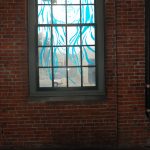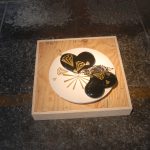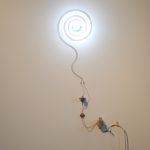Metaphoric Vinyl

Ten invited artists were asked to produce work using a Roland Camm-1 Servo, a machine commonly used in the sign-making industry. Although the participants shared certain characteristics as contemporary artists and printmakers, the only specific thing they have in common is that they have all utilized this versatile industrial instrument to produce beautiful and imaginative new artwork, exploring its possibilities and limitations.
All participants have tried various methods and cross-utilized equipment and materials while reconsidering the notion of digital versus analog processes. Because the method of production is specified, the theme then becomes one of collaboration and shared process within a certain range of commercial print technology. After scanning an initial idea, designs are vectorized (turned into discrete linework) and then manipulated via Adobe Illustrator or Photoshop. They are then cut by “Roland” into a vast array of vinyl films and heat transfer materials. The results vary with the whims of each individual artist, but the work all explores the possibilities of a newly accessible medium.
Some of the artists were chosen because they have had significant design experience, and the rest have an experimental approach to all media with a specific focus on printmaking. The gallery then became the site for exploration, intervention, and installation. Nick Cassway’s brush and ink drawn portraiture was transferred into large-scale images documenting his cohorts in different situations as they blow him a kiss or flip him the bird. Chris Vecchio re-engineered vinyl to make it conductive for electricity. Candy Depew’s work astounded with her decorative bent, a perfect match for this process. Peter Duffin’s exploration of cryptic graphic language and wood-patterned vinyl film made an extreme visual dichotomy. Sam Larson experimented with language and a 3-dimensional application of cut vinyl, and Alyse Bernstein extended her printmaking vocabulary into new realms using heat-transferred flocking. Matt Brownlee’s tattoo-influenced designs were reworked for applications that utilized the material and process, while Matthew Pruden took a new approach with anamorphic imagery. Nic Coviello continued his exploration of botanicals through a highly charged graphic application, and James Rosenthal took the theme literally by forfeiting some of his record collection and writing with plastic on plastic.










